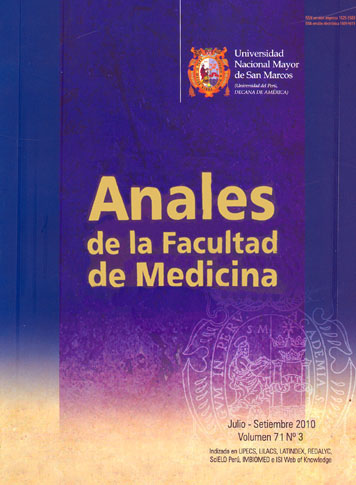Bidens pilosa chemoprotective effect on induced breast cancer in rats
DOI:
https://doi.org/10.15381/anales.v71i3.88Keywords:
Breast neoplasms, Bidens pilosa, phenolic compounds.Abstract
Introduction: Bidens pilosa species belonging to the Asteraceae family, known in Peru as love dry bur, is credited with anti-inflammatory, diuretic, hepatoprotective effects. Objectives: To determine the protective effect of phenolic compounds and flavonoids extracted from Bidens pilosa L whole plant on breast cancer induced in rats by 7,12-dimethylbenz (A) anthracene (DMBA). Design: Experimental. Setting: Laboratory of Pharmacology, Faculty of Medicine, Universidad Nacional Mayor de San Marcos, Lima, Peru. Biological material: Bidens pilosa L whole plant collected in Santiago de Cao, Ascope, La Libertad, and female rats. Interventions: Phenolic compounds and flavonoids were obtained by rapid column chromatography with solvents of increasing polarity; by thin layer chromatography on a preparative scale four phenolic compounds were isolated and elucidated by UV-Visible spectroscopy with shift reagents. Breast tumors were induced with DMBA administered orally to four groups of rats: normal control group, group with toxic inductor (TI) of cancer, group with TI and ethanolic extract, and group with TI and methanol fraction in doses of 300 mg/kg. Main outcome measures: Induced breast cancer protection. Results: Development of mammary adenocarcinoma tends to slow with treatments, more with the methanol fraction; the oxidative stress marker decreased in the groups treated with the plant, better with the methanol fraction; there were fewer micronuclei (genotoxicity) in animals receiving treatment. Conclusions: Under experimental conditions both Bidens pilosa methanol extracts and fractions halted induced breast cancer progression in rats.Downloads
Published
2010-09-13
Issue
Section
Trabajos originales
License
Copyright (c) 2010 Jorge Arroyo, Pablo Bonilla, Ernesto Ráez, Alejandro Barreda, Oscar Huamán

This work is licensed under a Creative Commons Attribution-NonCommercial-ShareAlike 4.0 International License.
Those authors who have publications with this magazine accept the following terms:
- Authors will retain their copyrights and guarantee the journal the right of first publication of their work, which will be simultaneously subject to Creative Commons Attribution License that allows third parties to share the work as long as its author and its first publication this magazine are indicated.
- Authors may adopt other non-exclusive licensing agreements for the distribution of the version of the published work (eg, deposit it in an institutional electronic file or publish it in a monographic volume) provided that the initial publication in this magazine is indicated.
- Authors are allowed and recommended to disseminate their work over the Internet (eg: in institutional telematic archives or on their website) before and during the submission process, which It can produce interesting exchanges and increase quotes from the published work. (See El efecto del acceso abierto ).
How to Cite
1.
Arroyo J, Bonilla P, Ráez E, Barreda A, Huamán O. Bidens pilosa chemoprotective effect on induced breast cancer in rats. An Fac med [Internet]. 2010 Sep. 13 [cited 2025 Jun. 13];71(3):153-9. Available from: https://revistasinvestigacion.unmsm.edu.pe/index.php/anales/article/view/88



